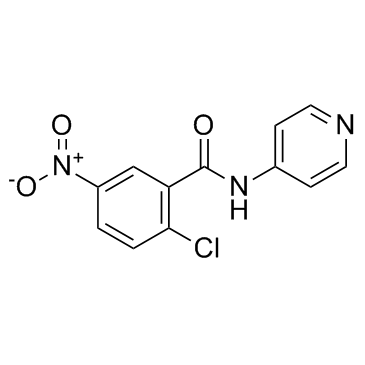313516-66-4
| Name | 2-chloro-5-nitro-N-pyridin-4-ylbenzamide |
|---|---|
| Synonyms |
2-Chloro-5-nitro-N-4-pyridinyl-benzamide Benzamide,2-chloro-5-nitro-N-4-pyridinyl
Benzamide,2-chloro-5-nitro-N-4-pyridinyl 2-chloro-5-nitro-N-pyridin-4-yl-benzamide Benzamide, 2-chloro-5-nitro-N-4-pyridinyl- 2-Chloro-5-nitro-N-(4-pyridinyl)benzamide 2-Chloro-5-nitro-N-4-pyridinylbenzamide 2-chloro-5-nitro-N-(pyridin-4-yl)benzamide T0070907 |
| Description | T0070907 is a potent PPARγ antagonist with a Ki of 1 nM. |
|---|---|
| Related Catalog | |
| Target |
PPARγ:1 nM (Ki) PPARδ:1.8 μM (Ki) PPARα:0.85 μM (Ki) |
| In Vitro | T0070907 (50 μM) pre-treatment impairs repair of IR-induced DNA DSBs in both ME-180 and SiHa cells treated with irradiated (4 Gy). T0070907 (0-50 μM) significantly decreases the levels of DNA-PKcs and RAD51 proteins in ME-180 and SiHa cells[1]. T0070907 (50 μM) treatment reduces the levels of α- and β-tubulin protein in a time-dependent manner, decreases the synthesis of DNA, and prevents the radiation-induced alterations in the cell cycle regulatory proteins of ME180 and SiHa cells[2]. T0070907 (10 µM) has cytotoxicity in an adipocyte-specific and PPARγ-independent manner. T0070907 increases oxidative stress in immature adipocytes[3]. T0070907 (1 μM) blocks the induction of adipogenesis by various treatments of the adipogenic cell line 3T3-L1. T0070907 covalently modifies PPAR on cysteine 313 in helix 3 of human PPAR 2[4]. |
| Kinase Assay | To determine the binding affinity of T0070907 to the PPARs, scintillation proximity assay (SPA) is performed with the following modifications. A 90 μL reaction contains SPA buffer (10 mM K2HPO4, 10 mM KH2PO4, 2 mM EDTA, 50 mM NaCl, 1 mM dithiothreitol, 2 mM CHAPS, 10% (v/v) glycerol, pH 7.1), 50 ng of GST-PPAR (or 150 ng of GST-PPAR), 5 nM 3H-labeled radioligands, and 5 μL of T0070907 in Me2SO. After incubation for 1 h at room temperature, 10 μL of polylysine-coated SPA beads (at 20 mg/mL in SPA buffer) are added, and the mixture is incubated for 1 h before reading in Packard Topcount. [3H]Rosiglitazone is used for PPAR, and [3H]GW2433 is used for PPAR and PPAR. |
| References |
| Density | 1.5±0.1 g/cm3 |
|---|---|
| Boiling Point | 381.7±37.0 °C at 760 mmHg |
| Molecular Formula | C12H8ClN3O3 |
| Molecular Weight | 277.663 |
| Flash Point | 184.6±26.5 °C |
| Exact Mass | 277.025421 |
| PSA | 87.81000 |
| LogP | 2.25 |
| Appearance | white |
| Vapour Pressure | 0.0±0.9 mmHg at 25°C |
| Index of Refraction | 1.684 |
| Storage condition | Store at RT |
| Water Solubility | DMSO: >10mg/mL | Soluble in DMSO at 10mg/ml. Insoluble in water. |
| Symbol |

GHS07 |
|---|---|
| Signal Word | Warning |
| Hazard Statements | H302-H319 |
| Precautionary Statements | P305 + P351 + P338 |
| Personal Protective Equipment | dust mask type N95 (US);Eyeshields;Gloves |
| Hazard Codes | Xn |
| Risk Phrases | 22-36 |
| Safety Phrases | 26 |
| RIDADR | NONH for all modes of transport |
| HS Code | 2933399090 |
|
~% 
313516-66-4 |
| Literature: US2003/134859 A1, ; |
| Precursor 2 | |
|---|---|
| DownStream 0 | |
| HS Code | 2933399090 |
|---|---|
| Summary | 2933399090. other compounds containing an unfused pyridine ring (whether or not hydrogenated) in the structure. VAT:17.0%. Tax rebate rate:13.0%. . MFN tariff:6.5%. General tariff:20.0% |

